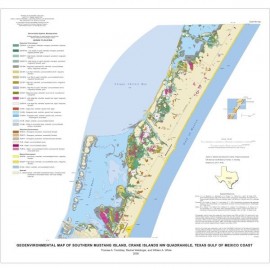Geological Circulars
-
Books & Reports
- Reports of Investigations
- Guidebooks
- Udden Series
- Geological Circulars
- Down To Earth
- Atlases of Major Oil and Gas Reservoirs
- Texas Memorial Museum Publications
- Environmental Geologic Atlas of the Texas Coastal Zone
- Mineral Resource Circulars
- Other Reports
- Seminars and Workshops
- Handbooks
- Submerged Lands of Texas
- Symposia
- Annual Reports
- Open File Reports
-
Maps & Cross Sections
- Thematic Maps
- Miscellaneous Maps, Charts & Sections
- Geologic Atlas of Texas
- STATEMAP Project Maps
- Geologic Quadrangle Maps
- Cross Sections
- Highway Geology Map
- Energy and Mineral Resource Maps
- Shoreline Change and Other Posters
- Wilcox Group, East Texas, Geological / Hydrological Folios
- Bouguer Gravity Atlas of Texas
- River Basin Regional Studies
- Featured Maps
- Posters
- Teachers & the Public
-
Geological Society Publications
- Gulf Coast Association of Geological Societies
- Alabama Geological Society
- Austin Geological Society
- Corpus Christi Geological Society
- Houston Geological Society
- Lafayette Geological Society
- Mississippi Geological Society
- New Orleans Geological Society
- South Texas Geological Society
- GCS SEPM Publications
- Historic BEG & UT Series
The Gulf Shoreline of Texas: Processes, Characteristics, and Factors in Use
GC7703
A free, digital version of this publication can be found on: Texas ScholarWorks
GC7703. The Gulf Shoreline of Texas: Processes, Characteristics, and Factors in Use, by J. H. McGowen, L. E. Garner, and B. H. Wilkinson. 27 p., 19 figs., 1977. ISSN: 0082-3309. Print.
To purchase this publication as a PDF download, please order GC7703D.
ABSTRACT
The State of Texas has about 367 miles of open Gulf shoreline, most of it typified by rather broad, sandy beaches and a comparatively mild climate that permits almost year-round use of this recreational resource. All but about 87 miles of the Gulf beach is accessible to the general public.
During the past 10 years or so, the Texas Gulf shoreline has experienced unprecedented development. Much of this development proceeded without proper consideration of the geomorphological features that constitute the Texas Gulf shoreline, the permanence or stability of these features, and the coastal processes that molded or that are presently modifying these features. Shoreline features that make up the Texas Gulf shoreline are erosional deltaic headlands (for example, the area between Sabine Pass and Rollover Pass), peninsulas, barrier islands, and one Modern delta (Brazos delta). Each of these major groups of features differs with respect to origin, history of development, and composition and size of materials. Most of the headlands, peninsulas, and barrier islands are being eroded. Approximately 60 percent of the shoreline is undergoing erosion.
Erosion is generally rapid along peninsulas and the erosional deltaic headlands (between Sabine Pass and Rollover Pass, San Luis Pass and Brown Cedar Cut, and from Brazos Santiago Pass to the mouth of the Rio Grande); it is less rapid along barrier islands. Deltaic headlands and peninsulas erode rapidly because waves commonly approach them at a high angle, thereby setting up longshore currents which transport sand-sized material away from the area. In addition, sand deposits associated with or which compose these features are commonly thin, a factor which promotes erosion. The beach and shoreface of barrier islands that lie in the vicinity of latitude 27° North are relatively stable because this is a zone of net longshore drift convergence; shorelines in this region will accrete slightly or remain in equilibrium for some time if barriers to longshore sediment transport are not erected to the north or south.
Shoreline stability is a factor that should be considered prior to developing any segment of the Texas Gulf shoreline. Other factors equally important include width of a particular shoreline feature, density of vegetation, presence or absence of fore-island dunes, and number and size of storm channels that transect the barriers, peninsulas, or deltaic headlands. Width of a particular shoreline feature is in part a function of sand availability; examples of broad shoreline features are barrier islands such as Galveston and Matagorda Islands. Man-made structures (motels, family dwellings, etc.) are relatively protected from hurricane wind and storm surge if they are situated on broad barrier islands behind fore-island dunes. Similar structures may be severely damaged or destroyed if placed on erosional deltaic headlands or on the narrow, low-profile peninsulas.
A variety of Gulf shoreline features exist along the Texas coast. Variability results from such factors as Pleistocene depositional and erosional history, sand availability, climatic conditions, density of vegetation, direction of wave approach, and direction of longshore sediment transport. Superimposed upon the natural setting are man's activities that tend to tip the balance toward disequilibrium. When man begins altering the coastal setting, the very processes which have interacted over the past 3,000 years or so to construct the Gulf shoreline features become agents of destruction.
Keywords: erosion, Galveston Island, Gulf, Matagorda Island, shoreline change, shorelines, Texas, Texas Gulf Coast
Citation
McGowen, J. H., Garner, L. E., and Wilkinson, B. H., 1977, The Gulf Shoreline of Texas: Processes, Characteristics, and Factors in Use: The University of Texas at Austin, Bureau of Economic Geology, Geological Circular 77-3, 27 p.






